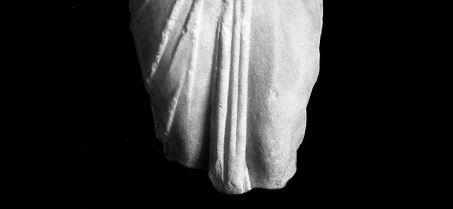 the
face
the
facethe knot
Isis-Aphrodite

It all depends on what you look at.
the head the
face
the
face
![]()
the knot
the body
Isis-Aphrodite
The head and the body of this statue were excavated separately in the
village of Karanis, Egypt. When the two pieces of the statue were put together,
its interpretation changed dramatically.
The head of this statue wears a variation of the Egyptian god Horus' headdress
of falcon scales and wings. The two locks of the elaborate wig are associated
with the Egyptian goddess Hathor.
The two locks and the pierced ear show that the head was female. The combination
of these symbols represents the goddess Isis, or an Egyptian queen.
The damaged face reflects a later phase in the statue's history. We do not know why the statue was defaced. This destruction may have been religiously motivated, or perhaps it was simply a practical way to re-use the head as building material.
The knotted cloth between the breasts is a common attribute of Isis. Literary
sources suggest that this knot symbolized Isis' sacred blood. Knots served
many purposes in Egyptian magic and ritual, including controlling creative
and destructive forces. Here, the knot and the bunched cloth draw attention
to Isis' breasts in a visual indicator of her role as the archetypal mother
and a powerful goddess of fertility.
The shawl falling off her left arm and the tightness of the drapery closely resemble statues of the Greek goddess of love, Aphrodite. The carving style and the use of marble are more at home in Greek sculptural traditions.
In the Roman period, Karanis had a diverse population that included Greeks,
Romans, and Egyptians. This statue of Isis-Aphrodite shows the fusion of
Greco-Roman and Egyptian traditions, both artistic and religious.
Isis-Aphrodite, and multi-cultural figures like her, pose problems of classification.
After this exhibit closed, this statue returned to the Greek and Roman gallery
in the Kelsey museum. In the past she has been installed in the Near Eastern
gallery.
Where does she belong?
| Go Back |